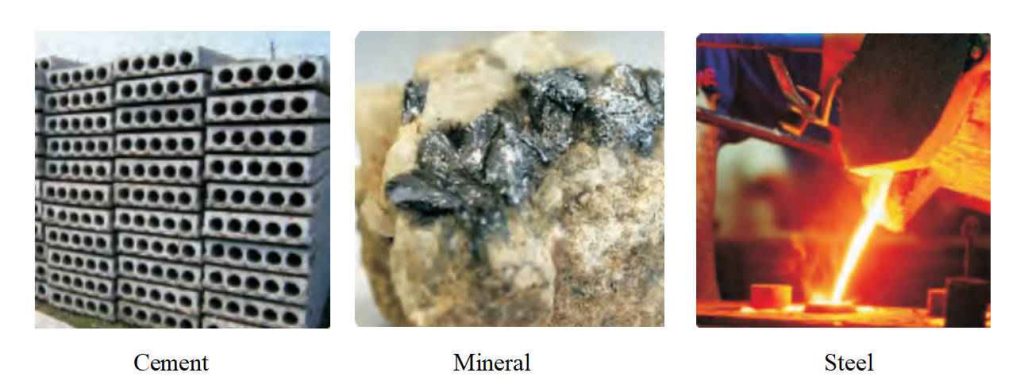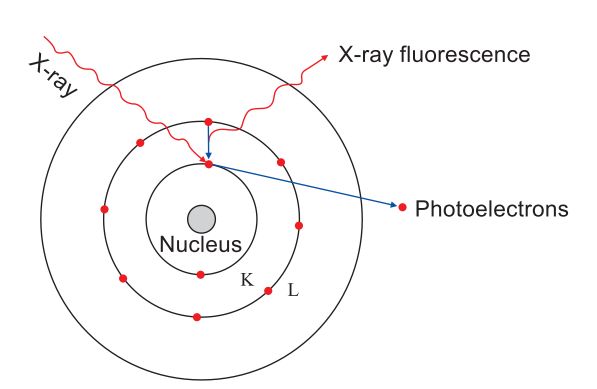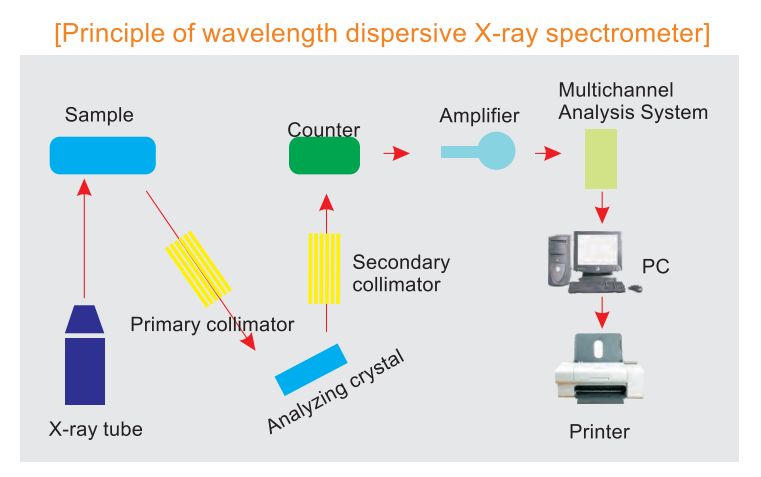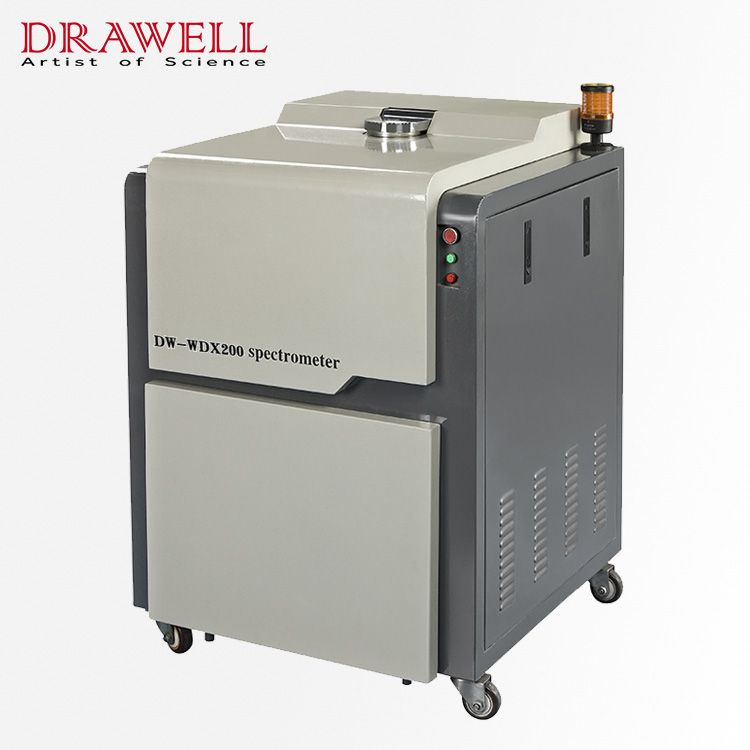Wavelength Dispersive X-ray Fluorescence Spectrometer DW-WDX200
(For Cement testing instruments)
DW-WDX200 Compact Multi-channel X-ray Fluorescence Spectrometer, with the configuration of 10 fixed channels and the capability to analyze 10 elements simultaneously, is able to conduct elemental analysis of arbitrary ten elements from Na to U based on the users’ requirements. This instrument is widely used in cement, steel, powder metallurgy, coal, petroleum, kaolin, glass, refractory materials, and environmental protection and accordingly an ideal choice for quality control in large and middle-scaled enterprises.
Application Fields
Building materials (cement, glass, ceramics)
Metallurgy (steel, non-ferrous metals)
Petroleum (trace elements S, Pb, and so on)
Chemical engineering
Geography and Mining
Commodity Inspection
Quality Inspection
Human Body Trace Elements Inspection

Specifications
| Temperature control accuracy | Setting value ±0.1 °C |
| Measurable elements | 10 arbitrary elements from Na to U |
| X-ray tube | 400W thin Be end window X-ray tube made by Varian company, Rh anode (Pd anode optional) |
| Analysis algorithms | Empirical coefficient algorithm and theoretical a-coefficient algorithm |
| Power Supply | AC220V, 1 KVA AC purified stabilized voltage power supply |
| High voltage supply | 200W (50KV4mA) |
| 12-hour stability of tube voltage & tube current | less than 0.05 % |
| Vacuum pump | biphase~220V, 2 liters |
| Industrial computer | industrial 104 computer |
| Analysis accuracy | °n-1(24 hours, percent content) W0.05 % |
| Measurement time of single sample | W3-5 minutes (including time for changing samples and vacuum pumping) |
| Detector | gas proportional detector + sealed proportional detector; 10 path 1024 channel independent pulse height analyzer |
| Vacuum system | independent vacuum pump station, easy maintenance |
| The highest vacuum degree | lower than 5 Pa |
| Gas flow system | High Sophisticated Gas Density Stabilizer with pressure stability up to ±0.003 KPa |
| Analysis software | Equipped with software for two quantitative analysis algorithms: empirical coefficient algorithm and theoretical a-coefficient algorithm. With innovative technology of full spectrum analysis, every spectrum line can be timely traced and corrected, which greatly improves the repeatability and stability of quantitative analysis and also serves as intuitive evidence of instrument status diagnosis. Complete measures for self-diagnosis are supplied. In-built RS-232 serial communication protocol, TCP / IP protocol (S/ C based on Socket) and OPC protocol (OPC server) all offer ways to share data with DCS or QCS system. |
Features
Excellent qualities
- Rapid and non-destructive analysis of powder and bulk samples
- Multi-channel high speed MCA offers timely measurement of every element peak, benefiting not only instrument debugging and failure diagnosis but also the enhancement of stability.
- Compared with sequential scan large power spectrometers, DW-WDX200 gains adequate analysis precision even when lower power and equal measurement time are adopted, which not only endows the instrument with high cost performance but also prevents wearing of the goniometer, prolongs the service life of the X-ray tube, minimize failures of the high voltage power supply and reduce the maintenance cost of the whole instrument.
Element characteristic X~ray radiation
Different elements have extra-nuclear electronic orbitals of different binding energies, as a result, they give off X-ray photons carrying energies different from each other when excited, that is, each element emits X-ray at its own special energy, representing the characteristic of this element and accordingly called characteristic X-ray. Characteristic X-ray of each element has its specific wavelength; so when we detect X-ray of a specific wavelength, we can identify the presence of the interested element in a sample.

Principle of Wavelength Dispersive Spectroscopy
When many elements coexist in a sample and get irradiated by primary X-ray emitted from the X-ray tube, they will emit their corresponding characteristic X-rays, which in general are termed X-RAY FLUORESCENCE. To separate and measure characteristic X-rays of these elements is called X-ray Fluorescence Spectroscopy.
As characteristic X-rays of different elements have specific wavelengths, they can be separated by using Crystal Diffraction based on Bragg Equation. This kind of spectroscopy is called Wavelength Dispersive Spectroscopy.
Bragg Equation:2dsinθ= nλ.
Where d is the interplanar spacing of the lattice planes of the crystals,θ is the angle of incidence and diffraction,λ is the wavelength of the incident radiation, N is the order of diffraction, and is an integer.

Software Overview

- Self-developed software system for X-ray Fluorescence Analyzers, applicable to the Windows operating system
- Easy manipulation realized by operating interface in all Chinese language
- With the innovative technology of full spectrum analysis, every spectrum line can be timely traced and corrected, which greatly improves the repeatability and stability of quantitative analysis and also serves as intuitive evidence of instrument status diagnosis.
- Equipped with software for two quantitative analysis algorithms: empirical coefficient algorithm and theoretical a-coefficient algorithm, among which the latter algorithm reduces the number of standard samples and retains adequate accuracy at the same time
- Analysis data treatment including linear fitting and all kinds of matrices correction
- Calculation of characteristic value based on analysis value
- Man-machine interaction, allowing you to set and modify parameters
- The timely output of analysis data and report
- Complete self-diagnosis measures
The Spectrum of Wavelength Dispersive Spectrometer

Results of Cement Measurement
Cement Standard XS04-2
| XS04-2 | Si | Al | Fe | Ca | Mg |
| Standard value | 12.71 | 2.86 | 3.09 | 43.29 | 1.6 |
| Average value | 12.724 | 2.862 | 3.074 | 43.318 | 1.584 |
| Max value | 12.79 | 2.98 | 3.11 | 43.35 | 1.69 |
| Min value | 12.66 | 2.83 | 3.06 | 43.3 | 1.62 |
| Range | 0.03 | 0.15 | 0.05 | 0.05 | 0.09 |
| SD | 0.015391 | 0.01091 | 0.004891 | 0.017776 | 0.014327 |
| RSD(%) | 0.120967 | 0.36987 | 0.160313 | 0.041037 | 0.875739 |
Results of Agglomerate Measurement
Below are the Results of Repeated Tests of the unknown sample:
| No. | Sample No | . Measurement Time | Fe(%) | CaO(%) | MgO(%) | SiO2(%) | So3(%) |
| 1 | 17# | 39395.56597 | 53.85 | 12.13 | 3.44 | 5.76 | 0.041 |
| 2 | 17# | 39395.56875 | 53.87 | 12.09 | 3.44 | 5.75 | 0.041 |
| 3 | 17# | 39395.57083 | 53.9 | 12.07 | 3.43 | 5.73 | 0.039 |
| 4 | 17# | 39395.57361 | 53.91 | 12.1 | 3.43 | 5.75 | 0.04 |
| 5 | 17# | 39395.57639 | 53.92 | 12.08 | 3.45 | 5.73 | 0.039 |
| 6 | 17# | 39395.57847 | 53.87 | 12.08 | 3.44 | 5.74 | 0.043 |
| 7 | 17# | 39395.58125 | 53.91 | 12.06 | 3.43 | 5.76 | 0.041 |
| 8 | 17# | 39395.58403 | 53.86 | 12.07 | 3.43 | 5.79 | 0.04 |
| 9 | 17# | 39395.58681 | 53.88 | 12.08 | 3.44 | 5.78 | 0.039 |
| 10 | 17# | 39395.58889 | 53.89 | 12.09 | 3.46 | 5.74 | 0.041 |
Test of 18-hour stability taken by unknown sample 17#; the results after total 306 times are:
| Constituent | Average | Min | Max | SD |
| Fe(%) | 53.89 | 53.851 | 53.92 | 0.013 |
| CaO(%) | 12.082 | 12.06 | 12.13 | 0.015 |
| MgO(%) | 3.443 | 3.43 | 3.47 | 0.011 |
| SiO2(%) | 5.75 | 5.73 | 5.79 | 0.011 |
| So3(%) | 0.0401 | 0.038 | 0.043 | 0.001 |
Results of Converter Slag Measurement
Below are the results of repeated tests of the unknown sample:
| No. | Sample No. | Measurement Time | Fe(%) | SiO2(%) | CaO(%) | MgO(%) |
| 1 | D1-2702A | 39398.70278 | 12.74 | 7.73 | 50.42 | 9.17 |
| 2 | DI-2702A | 39398.70556 | 12.74 | 7.73 | 50.38 | 9.17 |
| 3 | DI-2702A | 39398.70833 | 12.72 | 7.72 | 50.33 | 9.16 |
| 4 | DI-2702A | 39398.71111 | 12.71 | 7.71 | 50.32 | 9.15 |
| 5 | DI-2702A | 39398.71389 | 12.75 | 7.76 | 50.37 | 9.17 |
| 6 | DI-2702A | 39398.71597 | 12.73 | 7.85 | 50.29 | 9.12 |
| 7 | DI-2702A | 39398.71875 | 12.71 | 7.83 | 50.26 | 9.16 |
| 8 | DI-2702A | 39398.72153 | 12.73 | 7.81 | 50.27 | 9.12 |
| 9 | DI-2702A | 39398.72361 | 12.74 | 7.87 | 50.26 | 9.17 |
| 10 | DI-2702A | 39398.72639 | 12.75 | 7.86 | 50.25 | 9.2 |
Test of 15-hour stability taken by unknown sample D1-2702A#; the results after total 253 times are:
| Constituent | Average | Min | Max | SD |
| Fe(%) | 12.773 | 12.71 | 12.75 | 0.019 |
| SiO2(%) | 7.836 | 7.71 | 7.85 | 0.018 |
| CaO(%) | 50.227 | 50.42 | 50.25 | 0.027 |
| MgO(%) | 9.231 | 9.12 | 9.2 | 0.038 |


